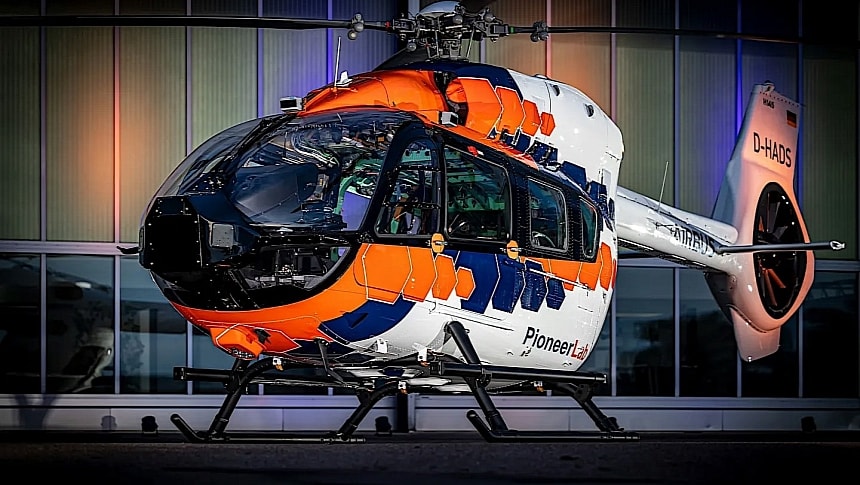The Farnborough Airshow is in full swing this week over in the UK, and as expected, a flood of news from the aviation industry keeps heading our way. This story's topic: a hybrid-electric helicopter demonstrator called PioneerLab.
PioneerLab is a project announced by European aerospace giant Airbus in the fall of last year. It is based on an existing helicopter, the H145, but it will be modified to test new materials, aerodynamic design cues, and technologies, including a hybrid-electric propulsion system, that should help it cut down on fuel consumption and emissions by as much as 30 percent compared to a similar, conventional aircraft.
The Airbus H145, previously known as the Eurocopter EC14, is a twin-engine helo that is usually deployed for utility purposes. The engines the aircraft normally uses are Turbomeca Arriel ones capable of developing 740 horsepower each.
They are more than enough to allow the H145 to carry as many as ten passengers and two pilots at speeds of 161 mph (260 kph) and for distances that can reach 404 miles (650 km). In standard configuration, the aircraft is the only one in its range to be able to take off and land at altitudes of 20,000 feet (6,000 meters).
Impressive as it is, the H145 with these engines on is not what Airbus needs to prove its point. That's why in the PioneerLab they will be replaced by a system comprising a conventional engine and a pair of electric motors, ran through a common gearbox. And now, thanks to the Farnborough Airshow, we know who will supply both systems.
The conventional engine is the work of Pratt & Whitney Canada, and it's the piece of hardware we know as the PW210. The technology plays the game in the 1,100 shaft horsepower class, so it will be more than enough to replace the stock powerplants.
Helping the engine in its mission will be two electric motors and their corresponding controllers, which are to be made by Collins Aerospace. Each motor is rated at 250 kW, but the way they are made allows them to be scaled up or down, depending on needs. In this application, the motors will be used to assist with take-off and landing by supplying extra torque.
Airbus has already begun building the PioneerLab at its facility in Donauworth, Germany. The rotor strike alerting system (RSAS, the tech that alerts pilots of objects in close proximity to the rotors) has already been put through its paces, and the automated take-off and landing system is now under scrutiny.
Work on the project will likely accelerate now that the engine and motor suppliers are known. Don't expect the PioneerLab to be ready for test flights sooner that 2027, though.
That's because aside from the hybrid-electric powertrain of the helicopter, the European company will also develop structural components made from bio-based and recycled materials. Additionally, new production processes will also be incorporated into the project, all with the goal of coming up with greener helicopters for the future.
The cherry on the cake, the PioneerLab will also be a testbed for increased autonomy tech designed to assist with take-off and landing.
The Airbus H145, previously known as the Eurocopter EC14, is a twin-engine helo that is usually deployed for utility purposes. The engines the aircraft normally uses are Turbomeca Arriel ones capable of developing 740 horsepower each.
They are more than enough to allow the H145 to carry as many as ten passengers and two pilots at speeds of 161 mph (260 kph) and for distances that can reach 404 miles (650 km). In standard configuration, the aircraft is the only one in its range to be able to take off and land at altitudes of 20,000 feet (6,000 meters).
Impressive as it is, the H145 with these engines on is not what Airbus needs to prove its point. That's why in the PioneerLab they will be replaced by a system comprising a conventional engine and a pair of electric motors, ran through a common gearbox. And now, thanks to the Farnborough Airshow, we know who will supply both systems.
The conventional engine is the work of Pratt & Whitney Canada, and it's the piece of hardware we know as the PW210. The technology plays the game in the 1,100 shaft horsepower class, so it will be more than enough to replace the stock powerplants.
Helping the engine in its mission will be two electric motors and their corresponding controllers, which are to be made by Collins Aerospace. Each motor is rated at 250 kW, but the way they are made allows them to be scaled up or down, depending on needs. In this application, the motors will be used to assist with take-off and landing by supplying extra torque.
Airbus has already begun building the PioneerLab at its facility in Donauworth, Germany. The rotor strike alerting system (RSAS, the tech that alerts pilots of objects in close proximity to the rotors) has already been put through its paces, and the automated take-off and landing system is now under scrutiny.
Work on the project will likely accelerate now that the engine and motor suppliers are known. Don't expect the PioneerLab to be ready for test flights sooner that 2027, though.
That's because aside from the hybrid-electric powertrain of the helicopter, the European company will also develop structural components made from bio-based and recycled materials. Additionally, new production processes will also be incorporated into the project, all with the goal of coming up with greener helicopters for the future.
The cherry on the cake, the PioneerLab will also be a testbed for increased autonomy tech designed to assist with take-off and landing.







